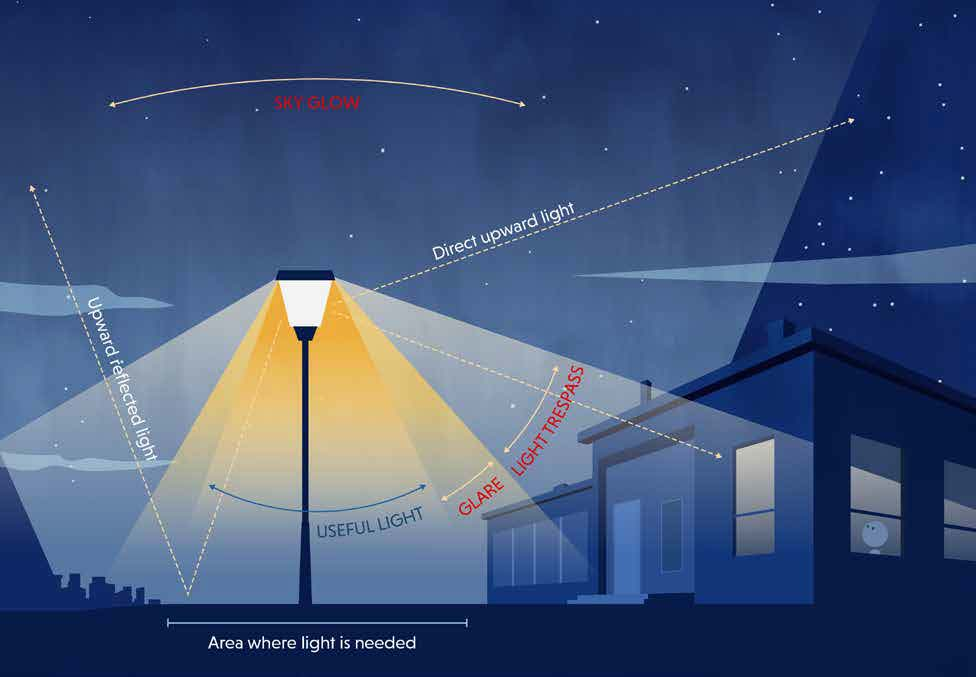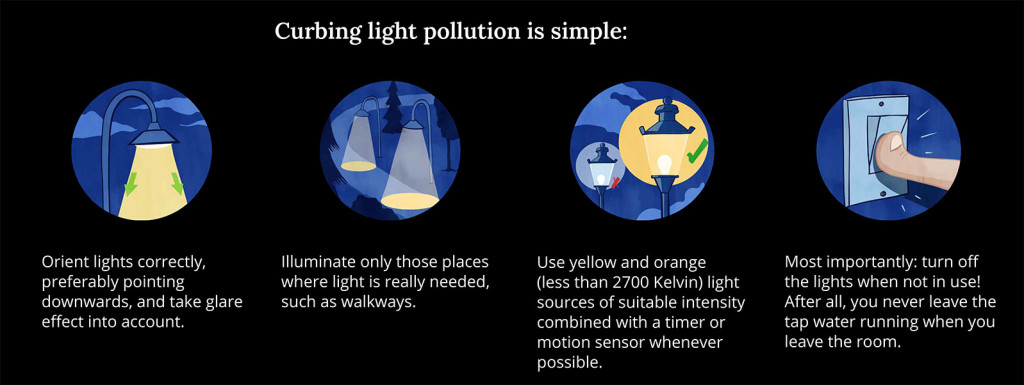Embracing the Night III: Conserving natural darkness
Section outline
-
Conserving darkness
The harmful effects of misdirected and excessive artificial lighting at night are easier to prevent and act on than many other forms of environmental impacts. Light pollution issues can be solved by meaningful and responsible lighting to limit unnecessary lighting and reduce unsuitable or excessive lighting.
Responsible lighting at night involves thoughtful and intentional actions to preserve darkness. For tourism sector and tourism destinations, protecting darkness can offer various values from the cultural, scientific, ecological, aesthetic, economical, to health and wellness benefits. To gain a deeper understanding of these values, be sure to explore our study module “Embracing the Night II: The Wonder of Dark Skies for Tourism”.
Preserving darkness and using responsible lighting at night allows us to enjoy the many benefits that natural darkness and starry skies bring to tourism. Responsible lighting is thoughtful lighting—it takes into account the effects of illumination on human health and wellbeing, as well as on animals, wildlife, plants, and the overall balance of nature. By considering these impacts, responsible lighting enhances both tourism experiences and destinations, while also supporting human wellness.
The Impact of LED Lighting and Light Pollution
As we have discussed in “Embracing the Night I: Basics of Natural Darkness”, accessibility to the light emitting diodes (LEDs), has rapidly accelerated the amount of unnecessary and excessive illumination at night—commonly referred to as light pollution. But LEDs also have several advantages, including adjustability, energy efficiency, and smart controls such as timers, dimmers, and motion sensors.
While artificial lighting is necessary at night to support vision and enable safe navigation, excessive and misdirected lighting poses significant risks: it impacts individuals’ and organisms’ biological and behavioural rhythms, disrupts the functioning of ecosystems, and can negatively impact interactions and structure of entire communities.
Depending on the type and intensity, light pollution has been proven to have a range of negative impacts and effects which can affect tourism economies and destinations. Light pollution is generated, for example, from buildings, streetlights, garden lights, facade lighting of buildings, advertising columns, greenhouses, industry lighting, parks and walking routes, and lights from sports fields and roads.

Light pollution and responsible lighting at night: meaningful lighting is lighting what is needed and directing light to where it is needed. Graphic by Teemu Åke.
Light pollution is commonly classified into four distinct types (DarkSky 2025):
- Skyglow: The brightening of the night sky over inhabited areas.
- Glare: Excessive brightness that causes visual discomfort.
- Light trespass: Light falling where it is not intended or needed.
- Clutter: Bright, confusing, and excessive groupings of light sources.
Activity: Identifying Light Pollution Around You
Based on the four types of light pollution shown above, reflect on the following:- Have you experienced any of these types of light pollution close to your accommodation or tourism facility? If so, write down where the light is coming from and how it affects you or how it makes you feel.
- Examine your accommodation or tourism facility and its surroundings. Can you identify any sources of light pollution? If yes, try to classify them according to the four types of light pollution.
Responsible Lighting Principles
With the help of well-thought-out directing and planning of lighting, we can easily influence not only the occurrence of light pollution but also prevent the financial costs associated with energy waste and unnecessary illumination. Many modern light sources offer a wide and adjustable range of features - such as different light wavelengths, dimming options, and colour temperature adjustment - that can support responsible lighting practices.

Ways to curb light pollution are simple. Graphic by Teemu Åke.
The five key principles to responsible lighting are: (https://darksky.org/resources/guides-and-how-tos/lighting-principles/)
- Useful - Use light only if it is needed
All light should have a clear purpose. Consider how the use of light will impact the area, including wildlife and their habitats. - Targeted - Direct light so it falls only where it is needed
Use shielding and careful aiming to target the direction of the light beam so that it points downward and does not spill beyond where it is needed. - Low level - Light should be no brighter than necessary
Use the lowest light level required. Be mindful of surface conditions, as some surfaces may reflect more light into the night sky than intended. - Controlled - Use light only when it is needed
Use controls such as timers or motion detectors to ensure that light is available when it is needed, dimmed when possible, and turned off when not needed. - Warm-colored - Use warmer-color lights where possible
Limit the amount of shorter wavelength (blue-violet) light to the least amount needed.
There are many practical techniques available when planning lighting—whether installing new fixtures, renovating existing ones, or designing façade lighting. The first step is to ask:
Is the lighting necessary?
- NO: don’t add light
- YES: consider how to implement it thoughtfully and responsibly by asking:
- What is the purpose of the lighting?
- Where exactly is the light needed?
- How much light is sufficient?
- When and for how long is the light required?
- Will the lighting be near sensitive areas, such as protected environments?
Activity: Taking Action on Light Pollution Around You
Based on your findings from the previous activity, reflect on the following:- Which actions based on the principles of responsible lighting could help address the sources of light pollution you identified?
- Have you noticed areas around your business that still require lighting for safety or other reasons? Review the checklist above to determine whether the lighting is genuinely necessary.